Whispers in the Thread
The Shirt as Messenger
Book Launch and Reading, Tues. Dec. 17 |
|
Shirt for the Pilgrimage
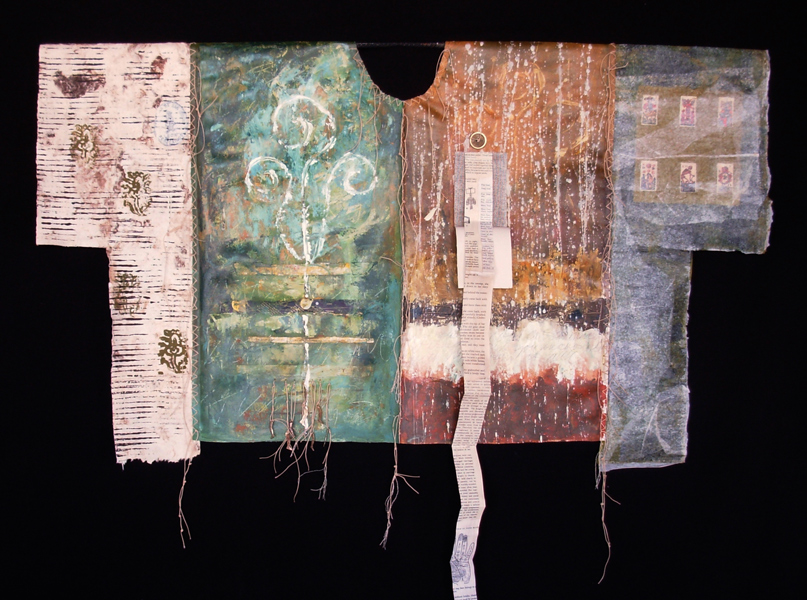
Shirt for the Pilgrimage
Mixed media
69 x 94 cm
2007
Each year, millions of seekers walk the Camino de Santiago in Spain, dip into the River Ganges in India, or join the millions who travel to the Basilica of Our Lady of Guadalupe in Mexico City. This kind of travel most often involves a sacred or ritual element. In my own experience, the journey, whether short or long, can be made extra-ordinary by donning a particular garment, perhaps a ceremonial vestment.
Considering and remembering this concept, I constructed a metaphorical huipil for an unnamed pilgrimage, adding universal and ancient symbols. To represent signposts that any of us might encounter, I attached found objects and milagros.
As I was working, I was called to include a pocket in the huipil's heart space. Stitching and gluing esoteric fragments from various writings, I created a long vertical accordion book. It can be folded into the pocket or left suspended, allowing the contents to reveal themselves slowly, when needed. As on any journey we undertake, surprises unfold if we allow them. It's good to have reminders that as we make our way on the road of life, everything we need is right there, in our hearts.
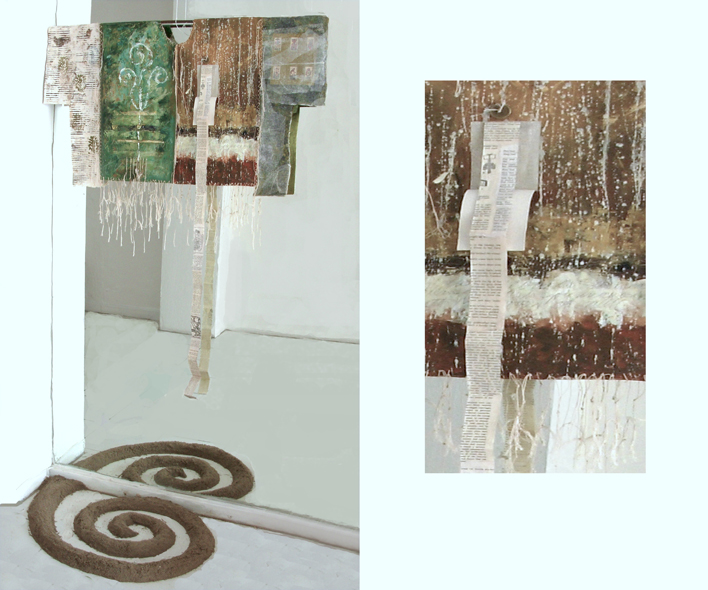 *****
The Silence of Sor Juana
*****
The Silence of Sor Juana
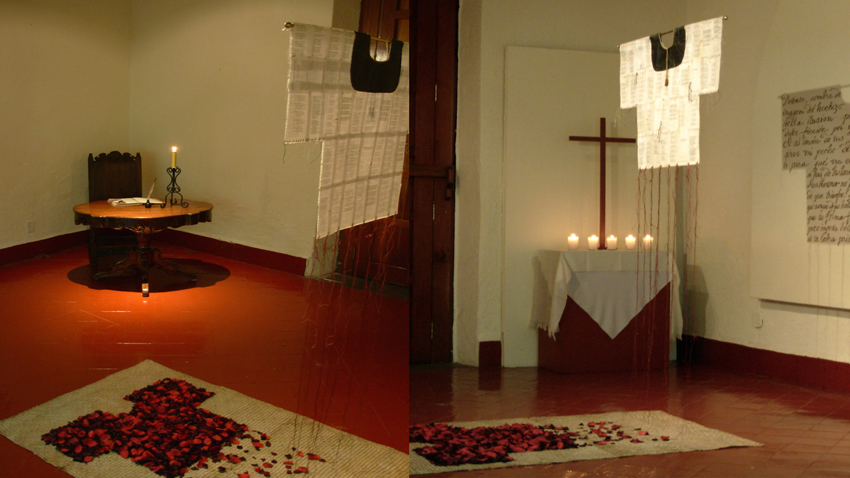
The Silence of Sor Juana
Pages from Sor Juana Inés de la Cruz's Poesia Amorosa, metallic thread
102 x 132 cm
2007-2008
Installation: Universidad del Claustro de Sor Juana, Mexico City
After moving to Mexico in 2004, I wanted to know more about the only woman to grace the currency, Sor Juana Inés de la Cruz. Years earlier, I had seen the film about her by Maria Luisa Bemburg titled I, the Worst of All. Then I discovered the lengthy biography by renowned writer Octavio Paz, who had determined it was time the world knew about Sor Juana. A nun, poet, philosopher, playwright, composer, scientist, feminist, and accountant in the mid-1600s, she proved a threat to the misogynist Church and State. They disapproved of her love poems to other women, essays critical of the Catholic religion, and her insistence on the right to education for women. These made her a target during the Spanish Inquisition. Juana was forced to renounce everything—her personal library of 4,000 books, her scientific and musical instruments, and her beloved passions: reading and writing.
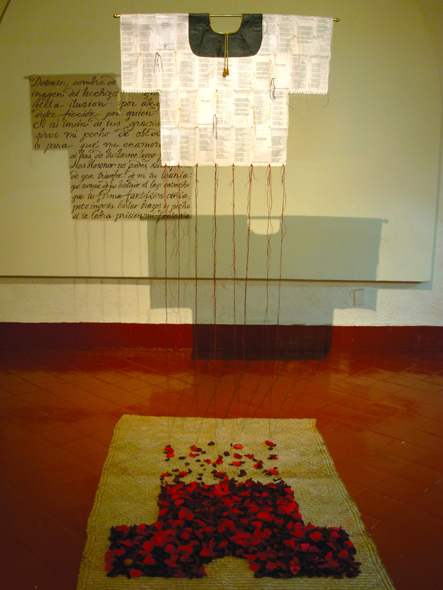
A book of her love poems inspired me to make a huipil using her own words. Stitching the pages together connected the threads of my own life: the sewing classes, religious education in a convent school, and the silencing that I, along with women throughout history, have experienced. I felt called to make a pilgrimage to her former convent—a colonial building, now a university—in Mexico City. As I stood over her tomb, I was haunted by a scene from the film in which Juana agreed to put down her pen, renounce, and sign a repentance in her own blood. Emboldened by her presence there, I proposed an exhibition, and it was accepted for the following year, 2010.
The exhibition space was a singular room that felt sparse and devoid of energy. I used that emptiness to imagine how Sor Juana's cell might have looked after her books and other treasures were taken from her. With her huipil suspended in the center of the room, the lighting created a ghost image on the wall behind. Inside that shadow, I penned one of her love letters in a script characteristic of the era. Her spirit appeared again as the shape reflected in red rose petals, signifying her blood and body as she prostrated herself. Red threads along the lower part of the huipil streamed to the floor, merging with the petals. I could almost see her signature with the words, "I, the Worst of All."
 *****
*****
|
|
|
|
"Whispers in the Thread celebrates 15 years of my huipil series. It has been an inspired, passionate deep dive into the mystery and seduction of a Mesoamerican garment that is at once text and textile. Borrowing from the idea of the shirt as messenger has transformed me from a painter into a fabric / collage / installation artist and along the way, an advocate for women's rights. This bilingual book features full color images of my art and poetry, stories, legends and artistic process, plus writings by contributing authors Kathryn Jordan, Merilyn Simonds, Maia Williams."
- Lena Bartula
|
|
|
|
*****
The Virgin of Guadalupe
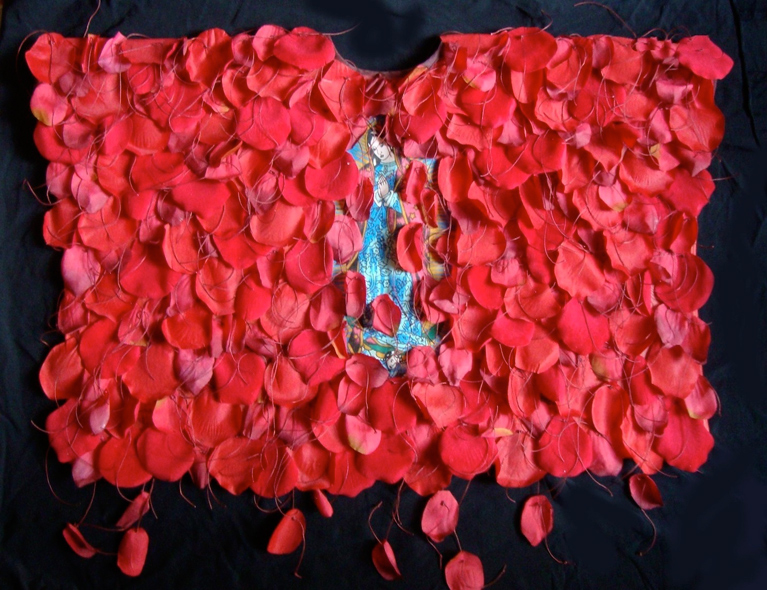
All Roses, All the Time
Rose petals made of silk, thread, paliacate
132 x 75 cm
2008
The Spanish had been occupying Mexico (New Spain) for about ten years when a Christianized indigenous peasant, Juan Diego, was stopped by a beautiful lady on the hill of Tepeyac. She said "Go tell the Bishop I want my temple built there". Here was the exact spot where a temple to the Aztec Goddess Tonantzin, mother of all the gods, had been destroyed. When Diego recounted the request, Archbishop Zumárraga told him told to ask the lady for proof of her wishes. Diego returned and the lady said to climb the hill and pick flowers as a sign of her request. Although it was winter and he was sure that nothing would be blooming, he found an abundance of roses, which he bundled into his tilma, a cloak woven from cactus fiber.
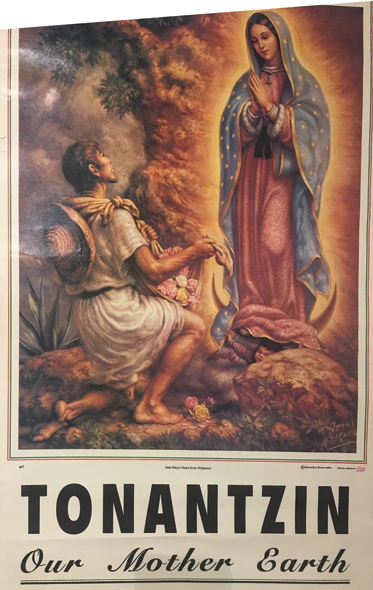
When presented to Zumárraga, Diego's tilma spilled the roses and all who saw them recognized them as Castilian, indigenous to Spain. More significantly, the tilma had been miraculously imprinted with her image, and she was then and there named The Virgen of Guadalupe, after the holy statue of a virgin in the Bishop's hometown of Extremadura. The tilma, preserved since that date with the familiar image of the Virgin head bowed and hands together in prayer, remains perhaps the most sacred object in Latin American countries. Now an icon in modern Mexico, she is also called Empress of the Americas, Queen of Mexico, Tonantzin, Little Mother, Coatlicue, and Coatlaxopeuh.
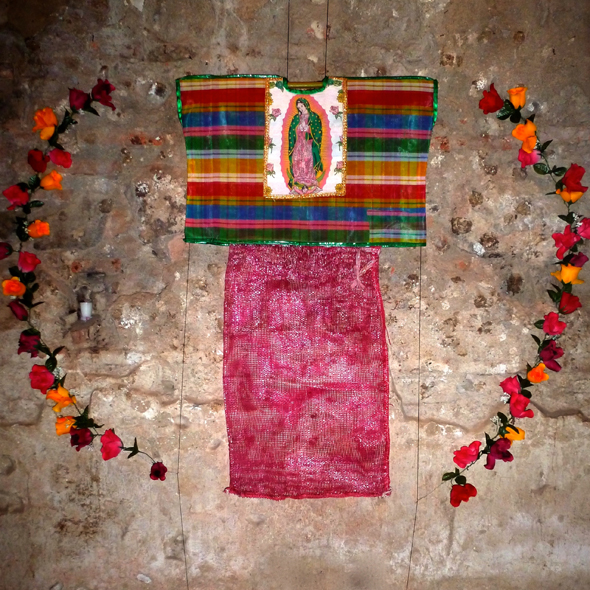
La Marchanta
Bolsas de mandado recicladas, paliacate
49x75 cm
2008
Instalación: Hotel Casa Santo Domingo,
Antigua, Guatemala
*****
|
|
|
|
"The gestation period for this book could have birthed a community of elephants. Initially, the idea for it came in early 2016 during my HILOS exhibition at Bellas Artes. Melba Levick was one of the first to suggest it, and I took it to heart. Later, I envisioned it as a small edition of handmade / artisan copies. I wanted to work with the maestras at Taller Leñateros in San Cristobal de Las Casa, but after spending much time there, it did not come to fruition for a variety of reasons. When I returned to San Miguel, the gallery space I currently occupy was offered to me, and it captured all my attention for two years. Then one day last May, I knew it was time to restart the effort. In reality, it's been in the works for years, but only on the front burner again for these last seven months. Whispers in the Thread, in the end, is still a labor of love. We've been in a passionate, completely devoted relationship, trying to understand each other's needs, listening to the muse as if we were in couples therapy. Laughing and crying some days, I would now say it parallels the stages we humans experience when we allow ourselves to be vulnerable, raw and open to learning, becoming and growing."
- Lena Bartula
| |
|
|
*****
Seeking Refuge
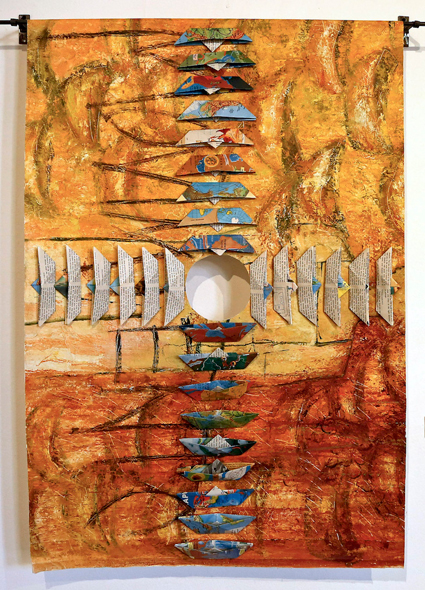
Seeking Refuge
Recycled painting, paper boats, thread
121 x 83 cm
2015
As the Syrian refugee crisis was peaking in 2015, I began folding paper boats from a 1950s era children's geography book. The story of people seeking refuge, of course, is larger than Syria itself. Those of us who have never experienced war, hunger, and overwhelming human misery in our homeland may not understand the need to flee. In reality, it could easily be our own story tomorrow. Climate change, political upheaval, and illegal appropriation of lands are historic shifts— wretched to witness, and most certainly unbearable to live through. Migration is, and always has been, a worldwide reality.
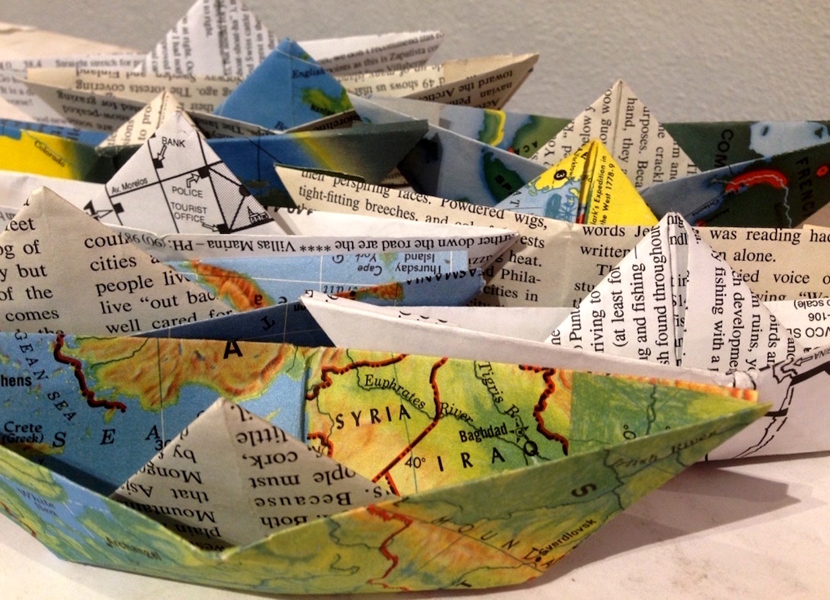
Update 2019:
Since I created this huipil and the poem that accompanies it, migrations continue to multiply. Close to my own reality is the mass exodus of Central Americans heading daily to Mexico's border, and from there to the U.S. border. They're fleeing unspeakable violence and poverty, knowing that anything is safer than their own countries. They imagine a kinder world in the U.S. and believe the myth of the American Dream—a country that will accept them, as I so naively wrote in the poem. Even as I write this, the migrants find themselves living in concentration camps, unable to move forward with their lives. Paper boats suddenly seem like the stuff of fairy tales, as those of us with compassion seek to find a solution to the crisis.
|
|
|
Seeking Refuge
It isn't a question of
how you leave,
or where you go.
The question has become
how do you stay.
When everything you know
is a lie, a heartache, a beast.
You and how many
thousands of others
will vie for a seat on a boat
that will torment you
and starve you
and perhaps even capsize.
If you arrive
you and how many thousands
will vie for a spot of safety
a zone of protection
safe harbor
on a shore of insanity.
If you survive
you and how many thousands
will drop to your knees
hug your children
ask for a sip of water
plead for dry clothes.
If we are kind
we and how many thousands
will welcome you
to our land
our home
our neighborhood
our human family.
|
|
|
*****
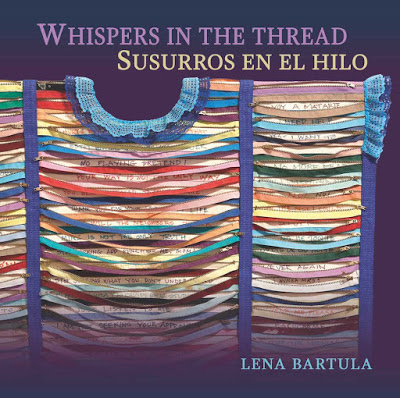 Book Launch and Reading
Book Launch and Reading
Tuesday, December 17, 5-7pm
Sala Literaria Bellas Artes
Hernández Macías 75, Centro
Read more about the event
**************
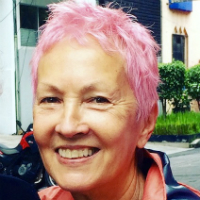
Lena Bartula has been a visual artist for more than thirty-five years. Her conceptual works include installation, mixed media and collaborative community projects. Her poems, essays and short stories have appeared in Nimrod International Journal, Dry Ground: Writing the Desert Southwest and Foreign Ground: Travelers' Tales, San Miguel Authors' Sala Anthology, Zingology and Dream Network Journal. Since 2004, Bartula makes her home in Mexico, and currently in San Miguel de Allende.
|
|
|
|
|
|
|
click ads
|